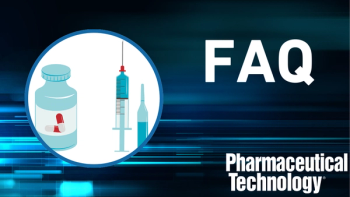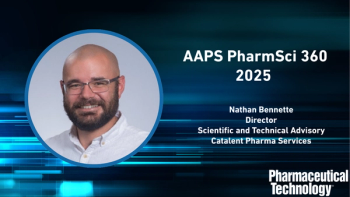
- Pharmaceutical Technology-09-01-2020
- Volume 2020 Supplement
- Issue 4
Evaluating Drug Substance–Drug Product Interplay Accelerates Development
Innovative approaches to drug screening—such as evaluation to identify the optimal solid state of a molecule and in-vitro characterization to establish the optimal solid state of a molecule and the ideal bioavailability-enhancing technology—can help drug developers meet accelerated development timelines while managing risk.
The drug development process is complex and time-consuming, with key steps including drug synthesis, solid form selection and development, as well as drug product selection and development. How the solid form and drug product interact is often a crucial part of the equation and may add to the complexity. This is also true for bioavailability-challenged molecules, which comprise a predominant component of the drug development pipeline.
Rather than basing formulation decisions on which technologies are available, drug developers advancing complex molecules will benefit from starting with an in-depth understanding of the API and formulation parameters impacting the target profiles of the drug product, and using that knowledge to make decisions that lead to optimized solutions for the medicine in production.
Development timelines are shortening
The development of new drug products, whether for new chemical entities (NCEs) or product enhancement, is a complicated, multi-disciplinary undertaking. Development activities may begin as early as the late stages of drug discovery and continue through post-market approval and lifecycle management. For NCEs, the bulk of the formulation work starts about one year prior to the investigational new drug (IND) application and continues through preparation of the new drug application (NDA), approximately 3–10 years (1).
The time from IND approval to NDA approval has remained constant at about eight years during the past four decades (1). However, more drugs are receiving accelerated status, which for certain classifications dramatically decreases the overall timeline. While the median time from IND application to FDA approval from 2012–2016 was eight years, that time was reduced to almost five years for breakthrough drugs and seven years for fast-track drugs not receiving breakthrough status (2). This adds additional pressure to development teams, especially for programs requiring complex drug substance and/or drug product manufacturing.
Adding to the complexity in drug development, and the increasing need for speed, are two additional trends in the pharmaceutical industry: molecules with drug delivery challenges and the type of companies who own the early-stage drug pipeline.
The rise of challenging molecules
The major challenge faced by the pharmaceutical industry, currently, is poor solubility, hence the low bioavailability of most new drugs being developed. More than 80% of drug candidates in the R&D pipeline are reported to be poorly soluble in water (3) with a notable influx of a large number of biologics. It is common for these low solubility drugs to be also extensively metabolized, which further reduces bioavailability (4). These drugs often require development of enabling drug product formulations, development of an alternative drug substance such as a salt or a cocrystal, and/or an alternative route of administration (e.g., inhalation or parenteral delivery to bypass first pass metabolism).
In 2018, only 19% of NMEs originated at larger pharma companies, down from 52% in 2011. The fraction of drugs owned by large pharma at filing was 32% in 2018, down from 62% in 2011 (2). More than 80% of the current drug pipeline is owned by small and emerging companies. These companies, often backed by venture capital, have fewer resources than large pharmaceutical firms and extensively use development and manufacturing partners within their business models. It has been estimated that more than 70% of these companies outsource at least some of their development work. Small biopharma companies are increasingly focused on specialty drugs not requiring extensive sales channels and, as such, are more likely to commercialize their molecules as opposed to mid- to late-stage divestiture to larger biopharma companies (2).
Taken together, this means that many biopharma companies are facing increased complexity and risk—developing more complex drugs with more distributed development and clinical teams, often under compressed timelines and funding. These companies can often benefit from using an integrated development and manufacturing partner to minimize the timelines, complexity, and risk associated with managing multiple partners and technology/process transfers. Integration includes phase-appropriate processing capability to take a molecule from non-GMP (good manufacturing practice) feasibility studies through clinical trials and to commercialization, as well as integrated capabilities encompassing drug substance and drug product, which can be especially critical for complex molecules and specialized target product profiles (5).
Drug substance–drug product interplay
The complex landscape of drug development includes drug synthesis, solid-form selection and development, as well as drug-product selection and development. The interplay between solid form and drug product is often crucial, and phase-appropriate solutions may be important to efficiently usher a drug through all development stages.
A commonly cited example involving the interplay of solid form and drug product is the case of ritonavir (Norvir) (6). Ritonavir reached the market in 1996 for treatment of human immunodeficiency virus as Norvir oral liquid and semi-solid capsules. The drug substance was an anhydrous crystal known as Form I. In 1998, however, many lots of the semi-solid capsules failed dissolution testing. Further analysis revealed the presence of a yet-undiscovered conformational polymorph, Form II, with much lower solubility. The capsule formulation was no longer viable. Abbott Laboratories had to pull the capsule product off the shelves and develop a new formulation. They released a lower-loading softgel capsule in 1999 and later developed Kaletra (ritonavir/lopinavir) tablets using an amorphous solid dispersion (ASD). The ideal drug product formulation for ritonavir changed in light of the discovery of a new polymorph.
Another case of where solid form and drug product interact is that of Olanzapine. Olanzapine is a Biopharmaceutics Classification System (BCS) II drug for the treatment of schizophrenia. Olanzapine free base can be crystallized in more than 25 crystal forms, including anhydrates, solvates, and hydrates (7). The Form I anhydrate is the most stable anhydrate known and was used in several immediate-release (IR) formulations, including tablets, orally disintegrating tablets, and intra-muscular injections. Researchers at Eli Lilly also discovered and patented several olanzapine pamoate hydrates and solvates (8) with much lower solubility and dissolution rate. This allowed the development of a long-acting injectable (LAI), which contained micronized crystals of olanzapine pamoate monohydrate. The LAI enabled improved patient compliance and added a year of exclusivity. The LAI drug product would not have been possible without developing a lower-solubility drug substance.
In programs where drug substance, drug product, solid-form screening, and clinical strategy are each the responsibility of a different company, identifying such issues and efficiently developing innovative solutions to solve them becomes even more challenging.
Developing a drug product strategy
A drug product strategy may itself be quite complicated. There are many formulation options available, and the formulation that works for preclinical toxicology may not be appropriate for clinical dosing. Additionally, a new indication may demand a different target product profile (TPP). The examples above included drug product changes as demanded by the physical form or the TPP. This section provides a small set of examples that the author has encountered in development work, illustrating the dynamic and complex nature of drug product selection:
An oral solution was used for preliminary animal pharmacokinetic (PK) and initial toxicology studies, before it was found that exposure was not high enough during dose escalation, presumably due to crystallization in vivo. A spray-dried dispersion (SDD) formulation led to higher exposure at elevated doses and was carried into clinical studies as a tablet. For Phase I, the drug loading in the SDD was kept low to limit crystallization risk but pushed higher during Phase II development to decrease pill burden.
An SDD was used in early PK and toxicology studies to reach the desired exposure, but was deemed unnecessary at the clinical dose and a crystalline form was carried forward into the clinic. This is one example where bioavailability enhancement formulation is required at high dose, but a simpler formulation is adequate for clinical dosing. It is important for a chemistry, manufacturing, and controls (CMC) lead to keep this in mind as animal studies designed to reach a particular concentration at the site of action may result in very different drug concentration profiles in the GI tract. In other words, the allometric scaling principles for efficacy and safety may be different than those for absorption (9).
An aqueous nanoparticle formulation was developed elsewhere during preclinical studies and carried through into Phase II clinical studies. For a new indication, a solid dosage form was more desirable. Spray-dried nanocrystals and a soft-gel compatible lipid nanosuspension gave similar PK to the liquid nanosuspension, while an SDD led to > 3x area under the curve (AUC), which measures the drug concentration over time, in an animal model. For Phase I clinical trials, a hot melt extrudate is being prepared because of advantageous throughput and dosing options relative to the SDD. Phase II studies will include a modified-release formulation of an amorphous dispersion.
Each drug and indication may require a different approach and one size does not fit all. The earlier that an experienced formulation team is involved in the decision making process, the better the overall results will be from early PK testing to commercialization.
Holistic approach to enhance bioavailability
When developing a formulation for bioavailability enhancement, it is important to identify what limits bioavailability and to determine the TPP and development strategy to the greatest extent possible with the entire team. As demonstrated previously, there are many considerations that require integration (or at least communication) between many teams in order to efficiently develop an appropriate drug product at each phase.
The technical challenge to be addressed is crucial to understand and may include low aqueous solubility, low permeability, slow dissolution rate, metabolism, efflux, and/or site-specific release in the GI tract. Additionally, the dose requirements for both preclinical and clinical dosing along with the TPP must be discussed, even if they are not fully understood early in the program. This information, along with extensive institutional knowledge of molecules with similar properties and TPPs, can be used to develop a formulation strategy, define the advantages and risks of each formulation, and understand when a new formulation and/or drug substance will be required for a second indication or route of administration.
In the following case study, the development of a suitable immediate-release dosage form for the BCS II/IV weak base, abiraterone acetate, is described. This drug was initially developed as a tablet of a crystalline API with moderately high bioavailability in the fed state, but with a large positive food effect. The fasted-state bioavailability is approximately 10 times lower than in the fed state. Key properties of abiraterone acetate and the reference listed drug (RLD) are shown in Table I. These properties suggested that either an amorphous dispersion or a lipid formulation could likely meet the requirements for increasing bioavailability without changing the drug substance form, which was desirable for this program.
Both amorphous dispersions and lipid formulations were considered during preformulation with reasonable promise. A simple calculation of the maximum absorbable dose (MAD) suggested that either approach could eliminate the food effect by increasing fasted-state absorption.
The amorphous dispersion was developed first because of the ability to deliver the required dose in a single tablet. Preliminary in-vitro dissolution of an SDD (Figure 1, left panel) was promising, but the SDD only provided a two-fold enhancement of AUC in a rodent model. Further analysis of in-vitro precipitation using fiber optic probes indicated that crystallization is very sensitive to the particulars of the dissolution test. The modified dissolution test was much more predictive of in-vivo performance, and SDD development was placed on hold due to the inability to increase fasted-state bioavailability sufficiently to eliminate the food effect.
Although a lipid-based formulation (LBF) could not meet the TPP of a single unit dose, the authors determined that it would be better to eliminate the food effect while keeping the number of units the same as the RLD than to reduce the number of units without eliminating the food effect. Several lipid formulations were developed with excellent sustainment of superstation in an in-vitro dissolution-digestion test. The developed LBF required four times as many units as the SDD to deliver the same dose, but increased bioavailability enough to eliminate the food effect in canines (Figure 2).
Conclusion
Drug development is a multi-faceted endeavor that requires collaboration between several groups to efficiently advance a molecule and deliver a drug product with the targeted therapeutic effect. The challenges inherent to drug development are exacerbated by the complexity of today’s molecules and target product profiles, as well as accelerated timeline requirements becoming the norm. Innovative and proactive approaches to drug screening and evaluation can help overcome these challenges for drug developers. Additionally, it is important that the collective product development team is well versed with all options for drug product and drug substance from the very early stages of development to ensure that decisions lead to optimized solutions, rather than simply geared to what is available.
References
1. T.J. Hwang, J.J. Darrow, and A.S. Kesselheim, JAMA, 318 (21) 2137–2138 (2017).
2. Lonza Internal Market Research.
3. L. Di, et al. Curr. Pharm. Des. 15 (19) 2184-2194 (2009).
4. C-Y Wu, L.Z. Benet, Pharm. Res. 22, 11–23 (2005).
5. J. A. DiMasi, PhD, Z. Smith, K. A. Getz, MBA, Clin Ther. 40 (6) 963-972 (2018)
6. J. Bauer, et al. Pharm. Res.18 (6) 859-866 (2001).
7. S. M. Reutzel-Edens, et al., Crystal Growth Des. 3 (6) 897-907 (2003).
8. C. A. Brunnell, et al., 2-methyl-thieno-benzodiazepine formulation. US patent 6,169,084 B1.
9. V. Sharma, J.H. McNeill, Br J Pharmacol.157 (6), 907-921 (2009).
About the Author
Michael Grass, PhD, is head of Solid Form Services at Lonza Pharma & Biotech.
Article Details
Pharmaceutical Technology
Supplement: APIs, Excipients, and Manufacturing
September 2020
Pages: s6–s10
Citation
When referring to this article, please cite it as M. Grass, "Evaluating Drug Substance–Drug Product Interplay Accelerates Development," APIs, Excipients, & Manufacturing 2020 Supplement (September 2020).
Articles in this issue
over 5 years ago
Tracing the Supply Chainover 5 years ago
Suitable Sterility Methods for Dimethyl Sulfoxide USP, PhEurover 5 years ago
Making the Ideal Dosage Formover 5 years ago
Optimizing Loss-in-Weight Feeding of Poorly Flowing Materialsover 5 years ago
Solid-Dose Continuous Manufacturing Presses OnNewsletter
Get the essential updates shaping the future of pharma manufacturing and compliance—subscribe today to Pharmaceutical Technology and never miss a breakthrough.




